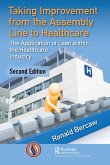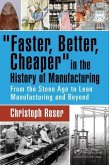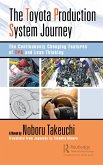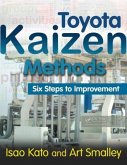Rajan Suri
The Practitioner's Guide to POLCA
The Production Control System for High-Mix, Low-Volume and Custom Products
Rajan Suri
The Practitioner's Guide to POLCA
The Production Control System for High-Mix, Low-Volume and Custom Products
- Gebundenes Buch
- Merkliste
- Auf die Merkliste
- Bewerten Bewerten
- Teilen
- Produkt teilen
- Produkterinnerung
- Produkterinnerung
POLCA stands for Paired-cell Overlapping Loops of Cards with Authorization. This system combines the best features of MRP and Kanban systems while overcoming their drawbacks for low-volume production. It includes novel features that are specifically designed to enable consistent delivery performance for high-mix/low-volume production. Finally, the crowning aspect of POLCA is that it is simple and yet remarkably effective: it is a visual card-based system that does not require investing in any specialized software, is easily understood by planners, schedulers and shop floor operators, and when…mehr
Andere Kunden interessierten sich auch für
![Lean in Agriculture Lean in Agriculture]() Vibeke Fladkjaer NielsenLean in Agriculture57,99 €
Vibeke Fladkjaer NielsenLean in Agriculture57,99 €![Taking Improvement from the Assembly Line to Healthcare Taking Improvement from the Assembly Line to Healthcare]() Ronald G. BercawTaking Improvement from the Assembly Line to Healthcare55,99 €
Ronald G. BercawTaking Improvement from the Assembly Line to Healthcare55,99 €![Faster, Better, Cheaper in the History of Manufacturing Faster, Better, Cheaper in the History of Manufacturing]() Christoph RoserFaster, Better, Cheaper in the History of Manufacturing60,99 €
Christoph RoserFaster, Better, Cheaper in the History of Manufacturing60,99 €![The Toyota Production System Journey The Toyota Production System Journey]() Noboru TakeuchiThe Toyota Production System Journey36,99 €
Noboru TakeuchiThe Toyota Production System Journey36,99 €![Lean Hospitals Lean Hospitals]() Mark GrabanLean Hospitals49,99 €
Mark GrabanLean Hospitals49,99 €![Toyota Kaizen Methods Toyota Kaizen Methods]() Isao KatoToyota Kaizen Methods60,99 €
Isao KatoToyota Kaizen Methods60,99 €![Toyota Production System Toyota Production System]() Yasuhiro Monden (Mejiro University)Toyota Production System91,99 €
Yasuhiro Monden (Mejiro University)Toyota Production System91,99 €-
-
-
POLCA stands for Paired-cell Overlapping Loops of Cards with Authorization. This system combines the best features of MRP and Kanban systems while overcoming their drawbacks for low-volume production. It includes novel features that are specifically designed to enable consistent delivery performance for high-mix/low-volume production. Finally, the crowning aspect of POLCA is that it is simple and yet remarkably effective: it is a visual card-based system that does not require investing in any specialized software, is easily understood by planners, schedulers and shop floor operators, and when properly implemented has resulted in disciplined, smooth operations at many companies.
Produktdetails
- Produktdetails
- Verlag: Taylor & Francis Ltd
- Seitenzahl: 454
- Erscheinungstermin: 16. März 2018
- Englisch
- Abmessung: 260mm x 183mm x 29mm
- Gewicht: 1152g
- ISBN-13: 9781138210646
- ISBN-10: 1138210641
- Artikelnr.: 52010202
- Herstellerkennzeichnung
- Libri GmbH
- Europaallee 1
- 36244 Bad Hersfeld
- gpsr@libri.de
- Verlag: Taylor & Francis Ltd
- Seitenzahl: 454
- Erscheinungstermin: 16. März 2018
- Englisch
- Abmessung: 260mm x 183mm x 29mm
- Gewicht: 1152g
- ISBN-13: 9781138210646
- ISBN-10: 1138210641
- Artikelnr.: 52010202
- Herstellerkennzeichnung
- Libri GmbH
- Europaallee 1
- 36244 Bad Hersfeld
- gpsr@libri.de
Rajan Suri is Emeritus Professor of Industrial Engineering at the University of Wisconsin-Madison. He received his Bachelors degree from Cambridge University (England) and his M.S. and Ph.D. from Harvard University. Dr. Suri is the inventor of the POLCA system and published the first description of POLCA in his book Quick Response Manufacturing: A Companywide Approach to Reducing Lead Times (Productivity Press, 1998). Dr. Suri is also the author of over 100 technical publications and several other books including It's About Time: The Competitive Advantage of Quick Response Manufacturing (Productivity Press, 2010). Professor Suri is the Founding Director of the Center for Quick Response Manufacturing (QRM) at the University of Wisconsin-Madison, a consortium in which around 300 companies have worked with the University on understanding and implementing QRM strategies. He is internationally regarded as an expert on the analysis of manufacturing systems, and served as Editor-in-Chief of the Journal of Manufacturing Systems. Dr. Suri has consulted for leading firms including 3M, Alcoa, AT&T, Boeing, Danfoss, Ford, Harley-Davidson, Hewlett Packard, IBM, John Deere, Mitsubishi, National Oilwell Varco, Pratt & Whitney, Rockwell Automation and TREK Bicycle. Consulting assignments in Europe and the Far East, along with projects for the World Bank, have given him an international perspective on manufacturing competitiveness. Professor Suri has received awards from the American Automatic Control Council, The Institute of Management Sciences, and the IEEE. In 1999, Dr. Suri was made a Fellow of the Society of Manufacturing Engineers (SME), and in 2006 he received SME's Albert M. Sargent Progress Award for the creation and implementation of the QRM strategy. In 2010, Dr. Suri was one of only 10 people to be inducted into the Industry Week 2010 Manufacturing Hall of Fame for the development of QRM and for his long-standing efforts in helping U.S. manufacturers stay competitive in the global marketplace. You can keep up to date on Professor Suri's activities and publications through his website: rajansuri.com.
Part I: Understanding POLCA. 1.POLCA-Simple Yet Highly Effective: A Tale of
Two Companies. 2. POLCA Explained: How It Works. 3. Operational Benefits of
POLCA; Part II: Implementing POLCA. 4.Pre-POLCA Assessment, Prerequisites,
and Preparation for POLCA. 5. Designing the POLCA System for Your
Situation; 6. Accommodating Exceptions within the POLCA Framework. 7.
Launching POLCA. 8 How We Designed and Launched POLCA in Three Days. 9.
Sustaining POLCA: Post-Implementation Activities. Part III: Industry Case
Studies. 10. From the United States: Using POLCA to Eliminate Material Flow
Chaos in an Aluminum Extrusion Operation. 11 From Canada: Applying POLCA in
a Pharmaceutical Environment. 12. From the Netherlands: Creating Flow and
Improving Delivery Performance at a Custom Hinge Manufacturer through QRM
and POLCA. 13. From Belgium: Metalworking Subcontractor Reduces Lead Times
by 85% Using QRM and POLCA. 14 From Poland: Dancing the POLCA in a Glass
Factory. 15. From Germany: Yes, Even Small Companies Can Benefit from
Implementing POLCA. Appendix A: Introduction to MCT: A Unified Metric for
Lead Time. Appendix B: Overview of Quick Response Manufacturing (QRM).
Appendix C: Perspectives on Applying MRP, Kanban, or Some Other Card-Based
Systems to HMLVC Production Environments. Appendix D: Capacity Clusters
Make High-Level MRP Feasible. Appendix E: The Sociotechnical Success
Factors of POLCA. Appendix F: Experiences with Using a POLCA Simulation
Game. Appendix G: Explanation of Formula for Number of POLCA Cards.
Appendix H: POLCA: A State-of-the-Art Overview of Research Contributions.
Appendix I: Additional Resources for POLCA Training and Games. Index. About
the Author
Two Companies. 2. POLCA Explained: How It Works. 3. Operational Benefits of
POLCA; Part II: Implementing POLCA. 4.Pre-POLCA Assessment, Prerequisites,
and Preparation for POLCA. 5. Designing the POLCA System for Your
Situation; 6. Accommodating Exceptions within the POLCA Framework. 7.
Launching POLCA. 8 How We Designed and Launched POLCA in Three Days. 9.
Sustaining POLCA: Post-Implementation Activities. Part III: Industry Case
Studies. 10. From the United States: Using POLCA to Eliminate Material Flow
Chaos in an Aluminum Extrusion Operation. 11 From Canada: Applying POLCA in
a Pharmaceutical Environment. 12. From the Netherlands: Creating Flow and
Improving Delivery Performance at a Custom Hinge Manufacturer through QRM
and POLCA. 13. From Belgium: Metalworking Subcontractor Reduces Lead Times
by 85% Using QRM and POLCA. 14 From Poland: Dancing the POLCA in a Glass
Factory. 15. From Germany: Yes, Even Small Companies Can Benefit from
Implementing POLCA. Appendix A: Introduction to MCT: A Unified Metric for
Lead Time. Appendix B: Overview of Quick Response Manufacturing (QRM).
Appendix C: Perspectives on Applying MRP, Kanban, or Some Other Card-Based
Systems to HMLVC Production Environments. Appendix D: Capacity Clusters
Make High-Level MRP Feasible. Appendix E: The Sociotechnical Success
Factors of POLCA. Appendix F: Experiences with Using a POLCA Simulation
Game. Appendix G: Explanation of Formula for Number of POLCA Cards.
Appendix H: POLCA: A State-of-the-Art Overview of Research Contributions.
Appendix I: Additional Resources for POLCA Training and Games. Index. About
the Author
Part I: Understanding POLCA. 1.POLCA-Simple Yet Highly Effective: A Tale of
Two Companies. 2. POLCA Explained: How It Works. 3. Operational Benefits of
POLCA; Part II: Implementing POLCA. 4.Pre-POLCA Assessment, Prerequisites,
and Preparation for POLCA. 5. Designing the POLCA System for Your
Situation; 6. Accommodating Exceptions within the POLCA Framework. 7.
Launching POLCA. 8 How We Designed and Launched POLCA in Three Days. 9.
Sustaining POLCA: Post-Implementation Activities. Part III: Industry Case
Studies. 10. From the United States: Using POLCA to Eliminate Material Flow
Chaos in an Aluminum Extrusion Operation. 11 From Canada: Applying POLCA in
a Pharmaceutical Environment. 12. From the Netherlands: Creating Flow and
Improving Delivery Performance at a Custom Hinge Manufacturer through QRM
and POLCA. 13. From Belgium: Metalworking Subcontractor Reduces Lead Times
by 85% Using QRM and POLCA. 14 From Poland: Dancing the POLCA in a Glass
Factory. 15. From Germany: Yes, Even Small Companies Can Benefit from
Implementing POLCA. Appendix A: Introduction to MCT: A Unified Metric for
Lead Time. Appendix B: Overview of Quick Response Manufacturing (QRM).
Appendix C: Perspectives on Applying MRP, Kanban, or Some Other Card-Based
Systems to HMLVC Production Environments. Appendix D: Capacity Clusters
Make High-Level MRP Feasible. Appendix E: The Sociotechnical Success
Factors of POLCA. Appendix F: Experiences with Using a POLCA Simulation
Game. Appendix G: Explanation of Formula for Number of POLCA Cards.
Appendix H: POLCA: A State-of-the-Art Overview of Research Contributions.
Appendix I: Additional Resources for POLCA Training and Games. Index. About
the Author
Two Companies. 2. POLCA Explained: How It Works. 3. Operational Benefits of
POLCA; Part II: Implementing POLCA. 4.Pre-POLCA Assessment, Prerequisites,
and Preparation for POLCA. 5. Designing the POLCA System for Your
Situation; 6. Accommodating Exceptions within the POLCA Framework. 7.
Launching POLCA. 8 How We Designed and Launched POLCA in Three Days. 9.
Sustaining POLCA: Post-Implementation Activities. Part III: Industry Case
Studies. 10. From the United States: Using POLCA to Eliminate Material Flow
Chaos in an Aluminum Extrusion Operation. 11 From Canada: Applying POLCA in
a Pharmaceutical Environment. 12. From the Netherlands: Creating Flow and
Improving Delivery Performance at a Custom Hinge Manufacturer through QRM
and POLCA. 13. From Belgium: Metalworking Subcontractor Reduces Lead Times
by 85% Using QRM and POLCA. 14 From Poland: Dancing the POLCA in a Glass
Factory. 15. From Germany: Yes, Even Small Companies Can Benefit from
Implementing POLCA. Appendix A: Introduction to MCT: A Unified Metric for
Lead Time. Appendix B: Overview of Quick Response Manufacturing (QRM).
Appendix C: Perspectives on Applying MRP, Kanban, or Some Other Card-Based
Systems to HMLVC Production Environments. Appendix D: Capacity Clusters
Make High-Level MRP Feasible. Appendix E: The Sociotechnical Success
Factors of POLCA. Appendix F: Experiences with Using a POLCA Simulation
Game. Appendix G: Explanation of Formula for Number of POLCA Cards.
Appendix H: POLCA: A State-of-the-Art Overview of Research Contributions.
Appendix I: Additional Resources for POLCA Training and Games. Index. About
the Author









